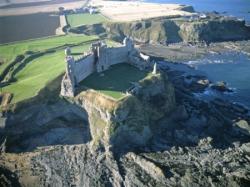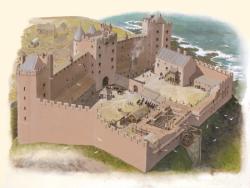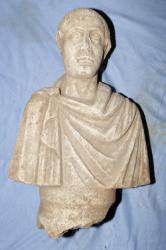INSTITUT SUPERIEUR D'ANTHROPOLOGIE
INSTITUTE OF ANTHROPOLOGY
ONLINE COURSES / COURS A DISTANCE
FALL TERM : OCTOBER 2015
REGISTER NOW
ROYAUME UNI – 
 Tantallon Castle - Archaeological excavations have uncovered tantalising glimpses of how Tantallon Castle might have looked in the 1400s. Based on recent discoveries, Historic Scotland has been able to commission several new reconstruction drawings of the East Lothian castle’s medieval history. In 2014, the demolished remains of a stone building in the castle’s outer close were found, and in 2015 archaeologists hope to shed more light on the development of these structures, and investigate the offensive ditch from the 1650/1 siege. Richard Strachan, senior archaeologist at Historic Scotland said: “The results of the recent excavations have shed light on hitherto unknown parts of the castle: last year, excavation in the castle’s courtyard revealed a wall that divided this courtyard into two zones, one perhaps more residential in nature and the other more of a service area. The remains of 14th century ranges and the demolished remains of a stone building in the castle’s outer close were also discovered, whilst excavated pottery, animal bone and other evidence has revealed how people lived during medieval times.”
Tantallon Castle - Archaeological excavations have uncovered tantalising glimpses of how Tantallon Castle might have looked in the 1400s. Based on recent discoveries, Historic Scotland has been able to commission several new reconstruction drawings of the East Lothian castle’s medieval history. In 2014, the demolished remains of a stone building in the castle’s outer close were found, and in 2015 archaeologists hope to shed more light on the development of these structures, and investigate the offensive ditch from the 1650/1 siege. Richard Strachan, senior archaeologist at Historic Scotland said: “The results of the recent excavations have shed light on hitherto unknown parts of the castle: last year, excavation in the castle’s courtyard revealed a wall that divided this courtyard into two zones, one perhaps more residential in nature and the other more of a service area. The remains of 14th century ranges and the demolished remains of a stone building in the castle’s outer close were also discovered, whilst excavated pottery, animal bone and other evidence has revealed how people lived during medieval times.”
http://www.scottishconstructionnow.com/8118/and-finally-new-images-depict-tantallon-castles-medieval-past/
BULGARIE –  - A marble bust of Roman Emperor Gordian III (r. 238-244 AD) has been seized by the Bulgarian policefrom a trafficker of antiques, and has been transferred to Bulgaria’s National Museum of History in Sofia, the Museum has announced in a media statement. In its statement, the National Museum of History in Sofia reminds that Roman Emperor Marcus Antonius Gordianus was the grandson of Emperor Gordian I. He was born in 225, and became Emperor of the Roman Empire in 238 AD at the age of 13, reigning in agreement with the Senate in Rome. Under Gordian III, the Roman Empire waged war on the Goths along the Lower Danube, i.e. in today’sBulgaria and Romania, in 238-239 AD, and achieved a victory against the Franks on the Rhein. In 241 AD, Emperor Gordian III went through the province of Thrace to reach Antioch in Syria where his forces successfully fought against the Persians. Also in 241, he married Furia Sabinia Tranquillina, daughter of the praetorian prefect, Timesitheus. Emperor Gordian III died in Mesopotamia in 244 AD. It notes also that the cause of Gordian III’s death remains unclear, with hypotheses ranging from a murder during a mutiny in the Roman forces to a battle wound, to a plot involving his successor, Emperor Philip I the Arab.
- A marble bust of Roman Emperor Gordian III (r. 238-244 AD) has been seized by the Bulgarian policefrom a trafficker of antiques, and has been transferred to Bulgaria’s National Museum of History in Sofia, the Museum has announced in a media statement. In its statement, the National Museum of History in Sofia reminds that Roman Emperor Marcus Antonius Gordianus was the grandson of Emperor Gordian I. He was born in 225, and became Emperor of the Roman Empire in 238 AD at the age of 13, reigning in agreement with the Senate in Rome. Under Gordian III, the Roman Empire waged war on the Goths along the Lower Danube, i.e. in today’sBulgaria and Romania, in 238-239 AD, and achieved a victory against the Franks on the Rhein. In 241 AD, Emperor Gordian III went through the province of Thrace to reach Antioch in Syria where his forces successfully fought against the Persians. Also in 241, he married Furia Sabinia Tranquillina, daughter of the praetorian prefect, Timesitheus. Emperor Gordian III died in Mesopotamia in 244 AD. It notes also that the cause of Gordian III’s death remains unclear, with hypotheses ranging from a murder during a mutiny in the Roman forces to a battle wound, to a plot involving his successor, Emperor Philip I the Arab.
http://archaeologyinbulgaria.com/2015/09/10/marble-bust-of-roman-emperor-gordian-iii-seized-from-trafficker-makes-it-to-bulgarias-national-museum-of-history/